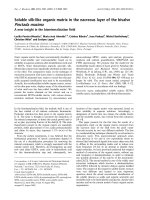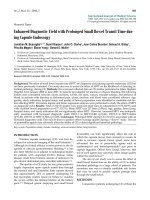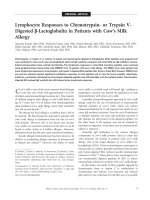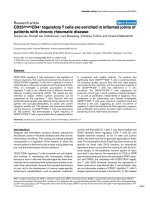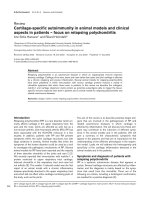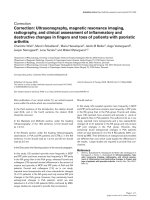Báo cáo y học: " Cigarette smoking associates with body weight and muscle mass of patients with rheumatoid arthritis: a cross-sectional, observational study" potx
Bạn đang xem bản rút gọn của tài liệu. Xem và tải ngay bản đầy đủ của tài liệu tại đây (358.63 KB, 7 trang )
Open Access
Available online />Page 1 of 7
(page number not for citation purposes)
Vol 10 No 3
Research article
Cigarette smoking associates with body weight and muscle mass
of patients with rheumatoid arthritis: a cross-sectional,
observational study
Antonios Stavropoulos-Kalinoglou
1,2,3
, Giorgos S Metsios
1,2,3
, Vasileios F Panoulas
3
,
Karen MJ Douglas
3
, Alan M Nevill
1,2
, Athanasios Z Jamurtas
4,5
, Marina Kita
3
,
Yiannis Koutedakis
1,4,5
and George D Kitas
2,3,6
1
School of Sport, Performing Arts & Leisure, Wolverhampton University, Gorway Road, Walsall, WS1 3BD, West Midlands, UK
2
Research Institute in Healthcare Science, University of Wolverhampton, Wulfruna Street, Wolverhampton, WV1 1LY, West Midlands, UK
3
Department of Rheumatology, Dudley Group of Hospitals NHS Trust, Russell's Hall Hospital, Pensnett Road, Dudley, DY1 2HQ, West Midlands, UK
4
Department of Sport and Exercise Science, University of Thessaly, Trikala-Karyes Road, Trikala, 42100, Greece
5
Institute of Human Performance & Rehabilitation, Trikala-Karyes Road, Trikala, 42100, Greece
6
ARC Epidemiology Unit, University of Manchester, Oxford Road, Manchester, M13 9PT, UK
Corresponding author: Antonios Stavropoulos-Kalinoglou,
Received: 20 Nov 2007 Revisions requested: 7 Jan 2008 Revisions received: 7 Mar 2008 Accepted: 20 May 2008 Published: 20 May 2008
Arthritis Research & Therapy 2008, 10:R59 (doi:10.1186/ar2429)
This article is online at: />© 2008 Stavropoulos-Kalinoglou et al.; licensee BioMed Central Ltd.
This is an open access article distributed under the terms of the Creative Commons Attribution License ( />),
which permits unrestricted use, distribution, and reproduction in any medium, provided the original work is properly cited.
Abstract
Introduction Rheumatoid arthritis (RA) is associated with
altered metabolism leading to muscle wasting. In the general
population, cigarette smoking is known to affect body
composition by reducing fat and inhibiting muscle synthesis.
Even though smoking has been implicated in the
pathophysiology and progression of RA, its possible effects on
body composition of such patients have not been studied. This
cross-sectional study aimed to identify potential associations of
smoking with body weight and composition of RA patients.
Methods A total of 392 patients (290 females) with RA were
assessed for body mass index (BMI), body fat (BF), fat-free
mass (FFM), and waist circumference. Erythrocyte
sedimentation rate, C-reactive protein, Disease Activity Score-
28, and Health Assessment Questionnaire score were used to
assess disease activity and severity. Smoking habit (current
smoker, ex-smoker, or never-smoker) and intensity (pack-years)
were also noted.
Results Current smokers had a significantly lower BMI
compared with ex-smokers (mean difference: male -2.6, 95%
confidence interval [CI]: -3.5 to -1.7; female: -2.6, 95% CI: -4.8
to -0.5) and never-smokers (mean difference: male -1.8, 95%
CI: -3 to -0.6; female: -1.4, 95% CI: -2.4 to -0.4). Similarly, the
BF of current smokers was lower compared with that of ex-
smokers (mean difference: male: -4.3, 95% CI: -7.5 to -1.2;
female: -3.4, 95% CI: -6.4 to -0.4) and never-smokers (mean
difference: male: -3.3, 95% CI: -6.3 to -0.4; female: -2.1, 95%
CI: -4 to -0.2). FFM did not differ between groups. Finally,
current smokers had a significantly smaller waist circumference
compared with ex-smokers only (mean difference: male: -6.2,
95% CI: -10.4 to -1.9; female: -7.8, 95% CI: -13.5 to -2.1).
Following adjustments for age, disease duration, and HAQ
score, smoking remained a significant predictor for BMI (P <
0.001), BF (P < 0.05), and waist circumference (P < 0.05).
Pack-years were inversely correlated with BF (r = -0.46; P <
0.001), and heavy smokers exhibited a significantly lower FFM
(P < 0.05) compared with all other participants.
Conclusion Within the limitations of a cross-sectional study, it
appears that cigarette smoking associates with reduced BMI
and BF in patients with RA and heavy smoking associates with
lower muscle mass. Smoking cessation appears to associate
with increased BMI, BF, and waist circumference in these
patients. These results should be confirmed in prospective
studies. Given the numerous adverse effects of smoking on
general health and RA, patients should be actively advised
against it. However, smoking cessation regimes in RA may need
to include more general lifestyle counselling, particularly about
weight control.
ANCOVA = analysis of covariance; ANOVA = analysis of variance; BF = body fat; BMI = body mass index; CI = confidence interval; CRP = C-reactive
protein; DAS28 = Disease Activity Score-28; ESR = erythrocyte sedimentation rate; FFM = fat-free mass; HAQ = Health Assessment Questionnaire;
RA = rheumatoid arthritis; REE = resting energy expenditure.
Arthritis Research & Therapy Vol 10 No 3 Stavropoulos-Kalinoglou et al.
Page 2 of 7
(page number not for citation purposes)
Introduction
Rheumatoid arthritis (RA), the commonest inflammatory arthri-
tis, is associated with altered metabolism [1]. Compared with
healthy controls, RA patients exhibit elevated resting energy
expenditure (REE) and enhanced muscle catabolism [2]. Such
changes may lead to rheumatoid cachexia (that is, involuntary
loss of fat-free mass [FFM] with a proportional increase of
body fat [BF]) in the presence of stable body weight [3,4].
Body composition changes, particularly BF increase, may
remain largely undetected by traditional assessments such as
the body mass index (BMI) [5]. Increased BF, together with
reduced levels of physical activity due to joint inflammation and
damage [3,6], is associated with several comorbidities, includ-
ing cardiovascular disease [7,8] as well as increased mortality
[3].
Cigarette smoking is an important risk factor for several dis-
eases [9]. It is also known to decrease body weight in healthy
individuals by reducing appetite and increasing REE [10]. In
contrast, smoking cessation may associate with significant
weight increase, which constitutes a major deterrent to smok-
ing control [11].
We have recently demonstrated that smoking further
increases REE in RA [12] and this could potentially augment
rheumatoid cachexia in these patients. Given the RA-related
alterations in body composition and the comorbidity associ-
ated with them, the examination of potential contributors to
muscle wasting, such as smoking, is important. The aim of this
cross-sectional study was to detect potential associations
between smoking and body weight, body composition, and
rheumatoid cachexia in RA patients.
Materials and methods
Participants
Consecutive patients attending routine rheumatology clinics at
the Dudley Group of Hospitals NHS Trust, UK, were invited to
participate. All applicable institutional and governmental regu-
lations concerning the ethical use of human volunteers were
followed during this research. The study had local research
ethics committee and research and development directorate
approvals, and all volunteers provided informed consent. A
total of 400 volunteers (108 males and 292 females) with RA
(1987 revised American College of Rheumatology criteria
[13]) were assessed. Of them, 8 (6 males) were excluded from
the analyses due to missing data for body composition. Data
from the remaining 392 (median age: 63.1 [55.5 to 69.6]
years; median disease duration: 10 [4 to 18] years) were ana-
lysed.
Assessments
All volunteers were subjected to the same data collection pro-
cedures overseen by the same trained investigators. Standing
height was measured to the nearest 0.5 cm on a Seca 214
Road Rod portable stadiometer (Seca gmbh & co. kg., Ham-
burg, Germany). Body weight and composition (that is, BF and
FFM) were assessed using a Tanita BC- 418 MA Segmental
Body Composition Analyzer (Tanita Corporation, Tokyo,
Japan). After initial manual entry of their demographic details,
participants stood barefooted on the analyzer and held the
handgrips provided until the apparatus printed the results. BMI
was calculated on the basis of measured height and weight in
kilograms per square metre. Waist circumference was also
measured. Contemporary disease activity was assessed by
the erythrocyte sedimentation rate (ESR), C-reactive protein
(CRP), and the Disease Activity Score-28 (DAS28) [14]. The
Anglicised version of the 40-item Stanford Health Assessment
Questionnaire (HAQ) [15] was used to measure physical dys-
function as a proxy of disease severity. Patients' self-reported
smoking status and intensity (that is, pack-years) were noted.
Data management and analyses
Data were analysed using the Statistical Package for Social
Sciences version 15.0 (SPSS Inc., Chicago, IL, USA). A pre-
liminary evaluation of the variables using a Kolmogorov-Smir-
nov test of normality revealed that none of them required
transformation to reach normality. Mean ± standard deviation
was calculated for all variables. Differences in BMI, BF, and
FFM between smoking groups are presented as mean differ-
ences with 95% confidence intervals (CIs).
According to their smoking status, patients were grouped into
never-smokers, current smokers, and ex-smokers. Analysis of
variance (ANOVA) assessed differences in demographic char-
acteristics, BMI, and body composition between groups for
each gender. Analysis of covariance (ANCOVA) was
employed to determine whether the differences observed
were attributed to smoking status or other confounding factors
(for example, gender, age, and disease characteristics).
In the current smoker and ex-smoker groups, further associa-
tions between pack-years with BMI and body composition
were examined. Thereafter, patients in these groups were
divided into quartiles according to pack-years. ANOVA was
employed to assess differences in the measured variables
between these subgroups. ANCOVA was used to correct for
any confounding factors.
Thereafter, patients were grouped according to (a) RA-spe-
cific BMI [5] and (b) gender-specific BF [16] thresholds into
underweight, normal weight, overweight, and obese. Subse-
quently, they were grouped based on gender-specific cut-off
Available online />Page 3 of 7
(page number not for citation purposes)
points for waist circumference [17] into low or high risk and for
FFM into low or normal FFM groups [18]. Chi-square analyses
were employed to assess differences between smoking
groups in the prevalence of overweight, obesity, high risk, and
low FFM. For all tests, the level of significance was set at a P
value of less than 0.05.
Results
Table 1 illustrates means ± standard deviations and the
ANOVA results for all studied parameters. Current smokers
had a significantly lower BMI than ex-smokers (mean differ-
ence: male -2.6, 95% CI: -3.5 to -1.7; female: -2.6, 95% CI: -
4.8 to -0.5) and never-smokers (mean difference: male -1.8,
95% CI: -3 to -0.6; female: -1.4, 95% CI: -2.4 to -0.4). Current
smokers also had a significantly lower BF compared with ex-
smokers (mean difference: male: -4.3, 95% CI: -7.5 to -1.2;
female: -3.4, 95% CI: -6.4 to -0.4) and never-smokers (mean
difference: male: -3.3, 95% CI: -6.3 to -0.4; female: -2.1, 95%
CI: -4 to -0.2). FFM did not differ between these groups (mean
difference: current smokers versus ex-smokers, male: -4.6,
95% CI: -10.7 to 1.6; female: -1.2; 95% CI: -3.8 to 1.4; cur-
rent smokers versus never-smokers, male: -2.7, 95% CI: -9.2
to 3.9; female: 0.1, 95% CI: -2.4 to 2.4). Current smokers had
a significantly smaller waist circumference than ex-smokers
(mean difference: male: -6.2, 95% CI: -10.4 to -1.9; female: -
7.8, 95% CI: -13.5 to -2.1) but not never-smokers (mean dif-
ference: male: -2.9, 95% CI: -10.6 to 4.9; female: -3.9, 95%
CI: -9.2 to 1.5). Also, ex-smokers had a larger waist circumfer-
ence than never-smokers but the difference was significant for
males only (mean difference: male: 3.3, 95% CI: 0.4 to 6.3;
female: 3.9, 95% CI: -0.4 to 8.1).
In ANCOVA with gender and smoking as factors and age,
DAS28, HAQ score, and disease duration as covariates,
smoking was a significant and independent predictor for BMI
(F
2,387
= 8; P < 0.001), BF (F
2,387
= 4.4; P < 0.05), and waist
circumference (F
2,387
= 7.9; P < 0.001). Smoking also
emerged as a significant predictor of FFM (F
2,387
= 5.1; P <
0.05), but inclusion of BMI as a covariate eliminated the effect
of smoking on FFM (P > 0.05).
There was a significant negative correlation between pack-
years and BF (r = -0.46; P < 0.001) in the current smoker and
the ex-smoker groups. This remained significant after adjust-
ment for gender, age, DAS28, HAQ score, and disease dura-
tion (F
1,389
= 4.8; P < 0.05). Following pack-year grouping into
quartiles (pack-group), ANOVA did not reveal any differences
for BMI or body composition among the current and ex-smoker
pack-groups. However, an ANCOVA model with gender and
pack-group as factors and age and weight as covariates (fol-
lowing stepwise elimination of ESR, CRP, DAS28, HAQ
score, and disease duration) revealed a significant effect of
pack-group on FFM (F
3,217
= 2.7; P < 0.05), with heavy smok-
ers exhibiting the lowest values. Mean (95% CI) values of this
variable in the pack-year subgroups appear in Figure 1.
Following BMI and BF grouping, chi-square analyses showed
significant differences (P < 0.05) in the prevalence of over-
Table 1
Measured variables of participants classified as current smokers (CS), ex-smokers (XS), and never-smokers (NS)
Gender Male (n = 102) Female (n = 290)
Smoking status CS XS NS CS XS NS
Number 20 50 32 49 97 144
Age, years 58.8 ± 8.1
a
65.2 ± 9.9
b
58.8 ± 15 57.4 ± 13.3
a
64.1 ± 11.2
b
60.7 ± 11.8
Height, cm 171.3 ± 7.1 174.3 ± 6.9 172.7 ± 7.7 160.9 ± 6.9 160.8 ± 6.8 159.5 ± 6.8
Weight, kg 76 ± 12.9
b, c
85.8 ± 13.6 84.1 ± 14.8 67.5 ± 14.2
a
74.8 ± 15.2 69.9 ± 13.6
Body mass index, kg/m
2
25.8 ± 3.3
b, c
28.4 ± 3.8 27.6 ± 4.6 26.1 ± 5.5
a, b
28.6 ± 5.4 27.5 ± 5
Body fat, percentage 24.5 ± 6.4
c, d
28.8 ± 6.8 27.8 ± 5.6 35.9 ± 7
a, b
39.2 ± 6.5 38.1 ± 6.7
Fat-free mass, kg 57.2 ± 9.4 61.7 ± 7.7 59.8 ± 10.3 42.5 ± 4.8 43.7 ± 6.1 42.5 ± 6.1
Waist circumference, cm 100 ± 7.9
c
106.2 ± 10.8
b
102.9 ± 9.3 90.8 ± 12.8
a
98.6 ± 13 94.7 ± 12.7
ESR, mm/hour 26.5 ± 20.5 22.8 ± 21.3 20.7 ± 19.7 30.5 ± 26 34.3 ± 32.7
b
25.5 ± 19.8
C-reactive protein, mg/L 13.3 ± 9.4 16.1 ± 20.4 16 ± 24.3 21.9 ± 23.2
b
21.4 ± 32.7
b
11.9 ± 12.5
DAS28 4 ± 0.9 4.1 ± 1.5 3.9 ± 1.6 4.5 ± 1.5 4.3 ± 1.5 4.1 ± 1.2
HAQ score 0.9 ± 0.8 1.4 ± 1 1.1 ± 0.9 1.5 ± 0.9 1.5 ± 0.9 1.5 ± 0.9
Disease duration, years 8.6 ± 7.8 11.9 ± 10.6 14.6 ± 12.7 11.4 ± 9.8 13.5 ± 10.8 13.5 ± 11.1
Values are presented as mean ± standard deviation.
a
Significant difference compared with XS (P < 0.05).
b
Significant difference compared with
NS (P < 0.05).
c
Significant difference compared with XS (P < 0.001).
d
Significant difference compared with NS (P < 0.001). DAS28, Disease
Activity Score-28; ESR, erythrocyte sedimentation rate; HAQ, Health Assessment Questionnaire.
Arthritis Research & Therapy Vol 10 No 3 Stavropoulos-Kalinoglou et al.
Page 4 of 7
(page number not for citation purposes)
weight and obesity among smoking groups, with obesity being
more prevalent in ex-smokers (50%) followed by never-smok-
ers (39%) and current smokers (30%). Similarly, ex-smokers
had a significantly (P < 0.05) higher prevalence of increased
waist circumference (69%) compared with never-smokers
(60%) and current smokers (49%). However, FFM did not dif-
fer between groups (P > 0.05) (Figure 2).
Discussion
To our knowledge, this is the first study to identify significant
associations between smoking, body weight, and body com-
position of RA patients: current smokers had a significantly
lower BMI and BF compared with never-smokers. Both BMI
and BF were significantly increased in ex-smokers, whereas
very heavy smoking appeared to associate with reduced FFM.
The study has several potential limitations. These are all cross-
sectional associations, and although they can serve for
hypothesis generation, they do not provide definitive evidence
for causality or directionality: longitudinal studies are required
for this. In addition, body composition was assessed by bioe-
lectrical impedance. This method has been validated [19-23]
and is thought to be suitable for body composition studies in
diverse populations [22-25], correlates well with the 'gold
standards' of dual-energy x-ray absorptiometry and hydrostatic
weighing [23], and is widely used in RA research
[5,12,24,26,27], but it has not actually been specifically vali-
dated in the RA population. Finally, although self-report of
smoking, especially smoking history, is generally reliable, both
under- and over-reporting can occur [28]. This is unlikely to
have influenced the primary findings of this study (that is, the
differences between current, ex-, and non-smokers), while any
misreporting in pack-years may have been smoothed by the
large number of participants. It is difficult to assess any other
selection bias: the prevalence of current, ex-, and non-smokers
among the participants of this study was similar to that
reported for local general population subjects of similar age
[29], although it was different from an RA cohort established
more than 10 years ago [30].
Our observations for BMI are consistent with those in the gen-
eral population. Both male and female smokers tend to have
decreased BMI compared with their non-smoking counter-
parts [10,31]. In contrast, significant BMI increases have been
noted after smoking cessation [11]. Smokers have increased
levels of leptin [32], which regulates food intake and fat depo-
sition [33], and reduced hypothalamic neuropeptide Y [34],
which regulates appetite [35]. Smoking-induced increases in
the levels of epinephrine, norepinephrine, and thyroid hor-
mones lead to increased energy expenditure at rest [36,37]
and during light physical activity [38-40]. However, these
effects are short-lived: after smoking cessation, leptin
decreases to levels below those expected for non-smokers of
similar weight [32] and resting energy expenditure (REE)
returns to normal [41].
In patients with RA, smoking has been shown to elevate REE
[12]; however, no data are available on other potential contrib-
utors to smoking-related weight loss or smoking cessation-
Figure 1
Fat-free mass for males (a) and females (b) according to pack-year groupingFat-free mass for males (a) and females (b) according to pack-year grouping. Data are presented as means with 95% confidence intervals. Pack-
year groups: 1, 1 to 9 pack-years; 2, 10 to 19 pack-years; 3, 20 to 34 pack-years; 4, greater than 35 pack-years. Asterisk indicates significant differ-
ence compared with group 1 (P < 0.05).
Available online />Page 5 of 7
(page number not for citation purposes)
related weight gain for this population. Although we did not
assess energy intake and expenditure or related regulators
(such as leptin), it is likely that the mechanisms behind the
reduced body weight of current smokers and the increased
body weight of ex-smokers with RA are similar to those
described for the general population.
Interestingly, the lower BMI of current smokers in the present
study seems to be due to decreased BF rather than FFM. A
possible mechanism by which smoking may affect fat metabo-
lism is through a reduction in neuropeptide Y. This molecule
not only stimulates food intake, but also promotes white fat
lipid storage and decreases brown fat thermogenesis [35], so
its inhibition through smoking would be expected to have the
opposite effects. Additionally, smoking results in decreased
adipose tissue lipoprotein lipase activity [42], which diverts fat
storage away from adipose tissue and toward utilization by
muscle [43], possibly leading to the decreased BF of smokers
[42,44]. In the present study, the inverse association between
smoking and BF appeared to be dose-dependent: increasing
pack-years associated with reducing BF levels. Smoking ces-
sation is thought to result in a reversal of the mechanisms
described above, leading to increases in BF [42] and, most
importantly, abdominal fat [45]. Indeed, among these RA
patients, ex-smokers seemed to be the most 'unhealthy' group
in terms of body weight and composition as they exhibited the
highest BMI, BF, and waist circumference values.
In predominantly healthy people who are from the general pop-
ulation and who do not have wasting muscle disease, smoking
of any intensity has been implicated in muscle wasting [10] by
impairing the process of muscle protein synthesis [46]. In con-
trast, in the present study, only very heavy smoking appeared
to associate with a reduction in FFM. It is possible that the
effect of smoking on muscle is of less significance than the
muscle loss associated with RA itself, as part of rheumatoid
cachexia. This hypothesis is supported by the finding that
increased duration of smoking (that is, pack-years) associated
with lower FFM in both current and ex-smokers, which sug-
gests the existence of a threshold below which smoking does
Figure 2
Prevalence of overweight and obesity, increased waist circumference, and low fat-free mass in smoking groupsPrevalence of overweight and obesity, increased waist circumference, and low fat-free mass in smoking groups. (a) Prevalence of overweight and
obesity based on rheumatoid arthritis (RA)-specific body mass index for current, ex-, and never-smokers. (b) Prevalence of overweight and obesity
based on body fat for current, ex-, and never-smokers. (c) Prevalence of high risk based on waist circumference for current, ex-, and never-smokers.
(d) Prevalence of low fat-free mass for current, ex-, and never-smokers. Chi-square analyses identified significant defences among smoking groups
for prevalence of (a) overweight and obesity based on body mass index (P < 0.05), (b) overweight and obesity based on body fat (P < 0.05), and
(c) increased waist circumference (P < 0.05). Prevalence of low fat-free mass did not differ between groups (P > 0.05).
Arthritis Research & Therapy Vol 10 No 3 Stavropoulos-Kalinoglou et al.
Page 6 of 7
(page number not for citation purposes)
not induce further muscle loss in RA patients. A longitudinal
study of the impact of smoking intensity (and cessation) on the
body composition of patients with RA may throw more light on
the mechanistic basis of these observations.
Overall, this study suggests that, in RA, smoking associates
with reduced body mass and fatness without inducing further
muscle loss, except in very heavy smokers; in contrast, smok-
ing cessation associates with increased body mass and fat-
ness. This should not be interpreted as favouring what is a very
unhealthy habit. Smoking cessation, even if it occurs in mid-
life, reduces most of the later risk of death from tobacco [47].
However, smoking cessation is known to result in body weight
increase, and this may affect some people's decision to stop
smoking [11,44,45]. Therefore, any smoking cessation regime
should be underpinned by more generalised lifestyle counsel-
ling, including advice on exercise and weight management.
This is emphasized by the fact that, based on recently
described RA-specific BMI [5], BF [16], and waist circumfer-
ence thresholds [48], ex-smokers have the highest prevalence
of obesity – both total and abdominal. FFM did not differ
between groups and the prevalence of low FFM was compa-
rable to that expected in age- and gender-matched healthy
individuals [18].
Conclusion
Within the limitations of this study, it is concluded that RA
smokers have a lower BMI and BF than RA non-smokers, while
heavy smokers also have a reduced FFM. A history of smoking
cessation appears to associate with increases in BMI, BF, and
waist circumference. Nevertheless, given the numerous
adverse effects of smoking on health, smokers with RA should
be actively advised against it, but smoking cessation programs
should include wider lifestyle counselling for weight control,
also focusing on increased physical activity and a healthy diet.
Competing interests
The authors declare that they have no competing interests.
Authors' contributions
AS-K participated in patient recruitment, data collection and
analysis, and the drafting of the manuscript. GSM participated
in patient recruitment and in data collection and analysis. VFP
and KMJD participated in patient recruitment, rheumatological
clinical assessments, and application of diagnostic/classifica-
tion criteria. AMN provided expert statistical advice and super-
vision and participated in the review of the manuscript. AZJ
participated in the inception and development of protocol and
in the review of the manuscript and served as PhD program
supervisor. MK provided advice on protocol development and
body composition assessments and participated in the review
of the manuscript. YK participated in the inception and devel-
opment of protocol and served as PhD program supervisor.
GDK participated in the inception and development of proto-
col, patient recruitment, clinical assessments, and analytical
approach, provided supervision in the drafting of the manu-
script, and served as PhD program supervisor and study guar-
antor.
Acknowledgements
This study was funded by a Dudley Group of Hospitals research and
development directorate cardiovascular program grant and a Wolver-
hampton University equipment grant. The Department of Rheumatology,
Dudley Group of Hospitals, has an infrastructure support grant from the
Arthritis Research Campaign (number 17682).
References
1. Roubenoff R, Roubenoff RA, Cannon JG, Kehayias JJ, Zhuang H,
Dawson-Hughes B, Dinarello CA, Rosenberg IH: Rheumatoid
cachexia: cytokine-driven hypermetabolism accompanying
reduced body cell mass in chronic inflammation. J Clin Invest
1994, 93:2379-2386.
2. Rall LC, Roubenoff R: Rheumatoid cachexia: metabolic abnor-
malities, mechanisms and interventions. Rheumatology
(Oxford) 2004, 43:1219-1223.
3. Walsmith J, Roubenoff R: Cachexia in rheumatoid arthritis. Int J
Cardiol 2002, 85:89-99.
4. Metsios GS, Stavropoulos-Kalinoglou A, Koutedakis Y, Kitas GD:
Rheumatoid cachexia: causes, significance and possible inter-
ventions. Hospital Chronicles 2006, 1:20-26.
5. Stavropoulos-Kalinoglou A, Metsios GS, Koutedakis Y, Nevill AM,
Douglas KM, Jamurtas A, van Zanten JJ, Labib M, Kitas GD: Rede-
fining overweight and obesity in rheumatoid arthritis patients.
Ann Rheum Dis 2007, 66:1316-1321.
6. Metsios GS, Stavropoulos-Kalinoglou A, Veldhuijzen van Zanten
JJ, Treharne GJ, Panoulas VF, Douglas KM, Koutedakis Y, Kitas
GD: Rheumatoid arthritis, cardiovascular disease and physical
exercise: a systematic review. Rheumatology (Oxford) 2008,
47:239-248.
7. Orzano J, Scott JG: Diagnosis and treatment of obesity in
adults: an applied evidence-based review. J Am Board Fam
Pract 2004, 17:359-369.
8. Poirier P, Giles TD, Bray GA, Hong Y, Stern JS, Pi-Sunyer FX,
Eckel RH: Obesity and cardiovascular disease: pathophysiol-
ogy, evaluation, and effect of weight loss. Arterioscler Thromb
Vasc Biol 2006, 26:968-976.
9. Frieden TR, Bloomberg MR: How to prevent 100 million deaths
from tobacco. Lancet 2007, 369:1758-1761.
10. Akbartabartoori M, Lean ME, Hankey CR: Relationships between
cigarette smoking, body size and body shape. Int J Obes
(Lond) 2005, 29:236-243.
11. Eisenberg D, Quinn BC: Estimating the effect of smoking ces-
sation on weight gain: an instrumental variable approach.
Health Serv Res 2006,
41:2255-2266.
12. Metsios GS, Stavropoulos-Kalinoglou A, Nevill AM, Douglas KMJ,
Koutedakis Y, Kitas GD: Smoking significantly increases basal
metabolic rate in patients with rheumatoid arthritis. Ann
Rheum Dis 2008, 67:70-73.
13. Arnett FC, Edworthy SM, Bloch DA, McShane DJ, Fries JF, Cooper
NS, Healey LA, Kaplan SR, Liang MH, Luthra HS, Medsger TA Jr,
Mitchell DM, Neustadt DH, Pinals RS, Schaller JG, Sharp JT,
Wilder RL, Hunder GG: The American Rheumatism Association
1987 revised criteria for the classification of rheumatoid arthri-
tis. Arthritis Rheum 1988, 31:315-324.
14. Prevoo ML, van 't Hof MA, Kuper HH, van Leeuwen MA, Putte LB
van de, van Riel PL: Modified disease activity scores that
include twenty-eight-joint counts. Development and validation
in a prospective longitudinal study of patients with rheumatoid
arthritis. Arthritis Rheum 1995, 38:44-48.
15. Kirwan JR, Reeback JS: Stanford Health Assessment Question-
naire modified to assess disability in British patients with
rheumatoid arthritis. Br J Rheumatol 1986, 25:206-209.
16. Obesity: preventing and managing the global epidemic. Report
of a WHO Consultation. World Health Organ Tech Rep Ser
2000, 894:1-253.
17. Expert Panel on Detection Evaluation and Treatment of High Blood
Cholesterol in Adults: Executive Summary of The Third Report
of The National Cholesterol Education Program (NCEP) Expert
Available online />Page 7 of 7
(page number not for citation purposes)
Panel on Detection, Evaluation, And Treatment of High Blood
Cholesterol In Adults (Adult Treatment Panel III). JAMA 2001,
285:2486-2497.
18. Schutz Y, Kyle UU, Pichard C: Fat-free mass index and fat mass
index percentiles in Caucasians aged 18–98 y. Int J Obes Relat
Metab Disord 2002, 26:953-960.
19. Tanaka K, Kim H, Nakanishi T, Amagi H: Multifrequency imped-
ance method for the assessment of body composition in Jap-
anese adults. J Exercise Sports Physiol 1999, 6:37-45.
20. Oppliger RA, Nielsen DH, Shetler AC, Crowley ET, Albright JP:
Body composition of collegiate football players: bioelectrical
impedance and skinfolds compared to hydrostatic weighing. J
Orthop Sports Phys Ther 1992, 15:187-192.
21. Gray D, Bray G, Gemayel N, Kaplan K: Effect of obesity on bioe-
lectrical impedance. Am J Clin Nutr 1989, 50:255-260.
22. Bolanowski M, Nilsson BE: Assessment of human body compo-
sition using dual-energy x-ray absorptiometry and bioelectri-
cal impedance analysis. Med Sci Monit 2001, 7:1029-1033.
23. Demura S, Sato S, Kitabayashi T: Percentage of total body fat as
estimated by three automatic bioelectrical impedance analyz-
ers. J Physiol Anthropol Appl Human Sci 2004, 23:93-99.
24. Lofthouse CM, Azad F, Baildam EM, Akobeng AK: Measuring the
nutritional status of children with juvenile idiopathic arthritis
using the bioelectrical impedance method. Rheumatology
(Oxford) 2002, 41:1172-1177.
25. Demura S, Sato S, Kitabayashi T: Estimation accuracy of percent
total body fat and percent segmental fat measured by single-
frequency bioelectrical impedance analysis with 8 electrodes:
the effect of difference in adiposity. J Sports Med Phys Fitness
2005, 45:68-76.
26. Lemmey A, Maddison P, Breslin A, Cassar P, Hasso N, McCann R,
Whellams E, Holly J: Association between insulin-like growth
factor status and physical activity levels in rheumatoid arthri-
tis. J Rheumatol 2001, 28:29-34.
27. Metsios GS, Stavropoulos-Kalinoglou A, Douglas KM, Koutedakis
Y, Nevill AM, Panoulas VF, Kita M, Kitas GD:
Blockade of tumour
necrosis factor-{alpha} in rheumatoid arthritis: effects on com-
ponents of rheumatoid cachexia. Rheumatology (Oxford) 2007,
46:1824-1827.
28. Fendrich M, Mackesy-Amiti ME, Johnson TP, Hubbell A, Wislar JS:
Tobacco-reporting validity in an epidemiological drug-use sur-
vey. Addict Behav 2005, 30:175-181.
29. Goddard E: General Household Survey 2005: Smoking and
drinking among adults, 2005 London, UK: Office for National Sta-
tistics; 2006.
30. Saag KG, Cerhan JR, Kolluri S, Ohashi K, Hunninghake GW,
Schwartz DA: Cigarette smoking and rheumatoid arthritis
severity. Ann Rheum Dis 1997, 56:463-469.
31. Albanes D, Jones DY, Micozzi MS, Mattson ME: Associations
between smoking and body weight in the US population: anal-
ysis of NHANES II. Am J Public Health 1987, 77:439-444.
32. Nicklas BJ, Tomoyasu N, Muir J, Goldberg AP: Effects of cigarette
smoking and its cessation on body weight and plasma leptin
levels. Metabolism 1999, 48:804-808.
33. Klok MD, Jakobsdottir S, Drent ML: The role of leptin and ghrelin
in the regulation of food intake and body weight in humans: a
review. Obes Rev 2007, 8:21-34.
34. Chen H, Hansen MJ, Jones JE, Vlahos R, Bozinovski S, Anderson
GP, Morris MJ: Cigarette smoke exposure reprograms the
hypothalamic neuropeptide Y axis to promote weight loss. Am
J Respir Crit Care Med 2006, 173:1248-1254.
35. Billington CJ, Briggs JE, Grace M, Levine AS: Effects of intracer-
ebroventricular injection of neuropeptide Y on energy metab-
olism. Am J Physiol. 1991, 260:R321-327.
36. Collins LC, Cornelius MF, Vogel RL, Walker JF, Stamford BA:
Effect of caffeine and/or cigarette smoking on resting energy
expenditure. Int J Obes Relat Metab Disord 1994, 18:551-556.
37. Collins LC, Walker J, Stamford BA: Smoking multiple high- ver-
sus low-nicotine cigarettes: impact on resting energy expend-
iture. Metabolism 1996, 45:923-926.
38. Perkins K, Epstein L, Marks B, Stiller R, Jacob R: The effect of nic-
otine on energy expenditure during light physical activity. N
Engl J Med
1989, 320:898-903.
39. Perkins KA: Metabolic effects of cigarette smoking. J Appl
Physiol 1992, 72:401-409.
40. Walker JF, Collins LC, Rowell PP, Goldsmith LJ, Moffatt RJ, Stam-
ford BA: The effect of smoking on energy expenditure and
plasma catecholamine and nicotine levels during light physi-
cal activity. Nicotine Tob Res 1999, 1:365-370.
41. Dallosso HM, James WP: The role of smoking in the regulation
of energy balance. Int J Obes 1984, 8:365-375.
42. Chajek-Shaul T, Berry EM, Ziv E, Friedman G, Stein O, Scherer G,
Stein Y: Smoking depresses adipose lipoprotein lipase
response to oral glucose. Eur J Clin Invest 1990, 20:299-304.
43. Sztalryd C, Hamilton J, Horwitz BA, Johnson P, Kraemer FB: Alter-
ations of lipolysis and lipoprotein lipase in chronically nico-
tine-treated rats. Am J Physiol. 1996, 270:E215-223.
44. Ferrara CM, Kumar M, Nicklas B, McCrone S, Goldberg AP:
Weight gain and adipose tissue metabolism after smoking
cessation in women. Int J Obes Relat Metab Disord 2001,
25:1322-1326.
45. Canoy D, Wareham N, Luben R, Welch A, Bingham S, Day N,
Khaw KT: Cigarette smoking and fat distribution in 21,828 Brit-
ish men and women: a population-based study. Obes Res
2005, 13:1466-1475.
46. Petersen AM, Magkos F, Atherton P, Selby A, Smith K, Rennie MJ,
Pedersen BK, Mittendorfer B: Smoking impairs muscle protein
synthesis and increases the expression of myostatin and
MAFbx in muscle. Am J Physiol Endocrinol Metab 2007,
293:E843-848.
47. Boyle P, Autier P, Bartelink H, Baselga J, Boffetta P, Burn J, Burns
HJ, Christensen L, Denis L, Dicato M, Diehl V, Doll R, Franceschi
S, Gillis CR, Gray N, Griciute L, Hackshaw A, Kasler M, Kogevinas
M, Kvinnsland S, La Vecchia C, Levi F, McVie JG, Maisonneuve P,
Martin-Moreno JM, Bishop JN, Oleari F, Perrin P, Quinn M, Rich-
ards M, et al.: European Code Against Cancer and scientific
justification: third version (2003). Ann Oncol 2003,
14:973-1005.
48. Grundy SM, Brewer HB Jr, Cleeman JI, Smith SC Jr, Lenfant C,
American Heart Association; National Heart, Lung, and Blood Insti-
tute: Definition of metabolic syndrome: Report of the National
Heart, Lung, and Blood Institute/American Heart Association
conference on scientific issues related to definition.
Circula-
tion 2004, 109:433-438.

